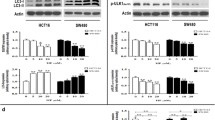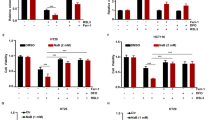Abstract
Butyrate is produced by the fermentation of undigested dietary fibers and acts as the promising candidate for cancer treatment. However, the mechanism underlying sodium butyrate (NaB)-induced autophagy in colorectal cancer is not yet completely understood. The expressions of LC3-II protein and mRNA were detected by western blot and quantitative RT-PCR in colorectal cancer (CRC) cell lines HCT-116 and HT-29, respectively. Autolysosome formation was observed by transmission electron microscope. AMPK and LKB1 were inhibited by chemical inhibitor or siRNAs and confirmed by western blot. NaB elevated the protein and mRNA expressions of LC3 in a dose-dependent manner. NaB treatment increased the formation of autolysosome and expression of phosphorylated liver kinase B1 (LKB1), AMP-activated protein kinase (AMPK), and acetyl-CoA carboxylase (ACC). Treatment with compound C (an inhibitor of AMPK) and siRNA-mediated knockdown of AMPK and LKB1 significantly attenuated NaB-induced autophagy in CRC cells. Collectively, these findings indicated that LKB1 and AMPK are critical for NaB-mediated autophagy and may act as the novel targets for colorectal cancer therapy in the future.






Similar content being viewed by others
References
Barshishat M, Levi I, Benharroch D, Schwartz B (2002) Butyrate down-regulates CD44 transcription and liver colonisation in a highly metastatic human colon carcinoma cell line. Br J Cancer 87:1314–1320
Breugom AJ, Swets M, Bosset JF, Collette L, Sainato A, Cionini L, Glynne-Jones R, Counsell N, Bastiaannet E, van den Broek CBM, Liefers GJ, Putter H, van de Velde CJH (2015) Adjuvant chemotherapy after preoperative (chemo) radiotherapy and surgery for patients with rectal cancer: a systematic review and meta-analysis of individual patient data. Lancet Oncol 16:200–207
Coker-Gürkan A, Arisan ED, Obakan P, Akalın K, Özbey U, Palavan-Unsal N (2015) Purvalanol induces endoplasmic reticulum stress-mediated apoptosis and autophagy in a time-dependent manner in HCT116 colon cancer cells. Oncol Rep 33:2761–2770
de Conti A, Tryndyak V, Koturbash I, Heidor R, Kuroiwa-Trzmielina J, Ong TP, Beland FA, Moreno FS, Pogribny IP (2013) The chemopreventive activity of the butyric acid prodrug tributyrin in experimental rat hepatocarcinogenesis is associated with p53 acetylation and activation of the p53 apoptotic signaling pathway. Carcinogenesis 34:1900–1906
Degenhardt K, Mathew R, Beaudoin B, Bray K, Anderson D, Chen G, Mukherjee C, Shi Y, Gélinas C, Fan Y, Nelson DA, Jin S, White E (2006) Autophagy promotes tumor cell survival and restricts necrosis, inflammation, and tumorigenesis. Cancer Cell 10:51–64
Donohoe DR, Garge N, Zhang X, Sun W, O’Connell TM, Bunger MK, Bultman SJ (2011) The microbiome and butyrate regulate energy metabolism and autophagy in the mammalian colon. Cell Metab 13:517–526
Donohoe DR, Collins LB, Wali A, Bigler R, Sun W, Bultman SJ (2012) The Warburg effect dictates the mechanism of butyrate-mediated histone acetylation and cell proliferation. Mol Cell 48:612–626
Duivenvoorden WC, Beatty LK, Lhotak S, Hill B, Mak I, Paulin G, Gallino D, Popovic S, Austin RC, Pinthus JH (2013) Underexpression of tumour suppressor LKB1 in clear cell renal cell carcinoma is common and confers growth advantage in vitro and in vivo. Br J Cancer 108:327–333
Gan R, Li H (2014) Recent progress on liver kinase B1 (LKB1): expression, regulation, downstream signaling and cancer suppressive function. Int J Mol Sci 15:16698–16718
Ha J, Guan KL, Kim J (2015) AMPK and autophagy in glucose/glycogen metabolism. Mol Asp Med 46:46–62
Hale AN, Ledbetter DJ, Gawriluk TR, Rucker EB III (2013) Autophagy: regulation and role in development. Autophagy 9:951–972
Han D, Li SJ, Zhu YT, Liu L, Li MX (2013) LKB1/AMPK/mTOR signaling pathway in non-small-cell lung cancer. Asian Pac J Cancer Prev 14:4033–4039
Hardie DG (2013) The LKB1-AMPK pathway-friend or foe in cancer? Cancer Cell 23:131–132
Hofmanova J, Hyrslova Vaculova A, Kozubik A (2013) Regulation of the metabolism of polyunsaturated fatty acids and butyrate in colon cancer cells. Curr Pharm Biotechnol 14:274–288
Huang YH, Chen ZK, Huang KT, Li P, He B, Guo X, Zhong JQ, Zhang QY, Shi HQ, Song QT, Yu ZP, Shan YF (2013) Decreased expression of LKB1 correlates with poor prognosis in hepatocellular carcinoma patients undergoing hepatectomy. Asian Pac J Cancer Prev 14:1985–1988
Koehler BC, Jäger D, Schulze-Bergkamen H (2014) Targeting cell death signaling in colorectal cancer: current strategies and future perspectives. World J Gastroenterol 20:1923–1934
Lane AA, Chabner BA (2009) Histone deacetylase inhibitors in cancer therapy. J Clin Oncol 27:5459–5468
Lapinska K, Housman G, Byler S et al (2016) The effects of histone deacetylase inhibitor and calpain inhibitor combination therapies on ovarian cancer cells. Anticancer Res 36:5731–5742
Lazarova DL, Bordonaro M, Carbone R, Sartorelli AC (2004) Linear relationship between Wnt activity levels and apoptosis in colorectal carcinoma cells exposed to butyrate. Int J Cancer 110:523–531
Lee HY, Chung KJ, Hwang IH, Gwak J, Park S, Ju B, Yun E, Kim DE, Chung YH, Na MK, Song GY, Oh S (2015) Activation of p53 with ilimaquinone and ethylsmenoquinone, marine sponge metabolites, induces apoptosis and autophagy in colon cancer cells. Mar Drugs 13:543–557
Lee KY, Kim JR, Choi HC (2016) Genistein-induced LKB1-AMPK activation inhibits senescence of VSMC through autophagy induction. Vasc Pharmacol 81:75–82
Li GH, Lin XL, Zhang H et al (2004) Ox-Lp(a) transiently induces HUVEC autophagy via an ROS-dependent PAPR-1-LKB1-AMPK-mTOR pathway. Atherosclerosis 243:223–235
Liu EY, Ryan KM (2012) Autophagy and cancer - issues we need to digest. J Cell Sci 125:2349–2358
Liu W, Monahan KB, Pfefferle AD, Shimamura T, Sorrentino J, Chan KT, Roadcap DW, Ollila DW, Thomas NE, Castrillon DH, Miller CR, Perou CM, Wong KK, Bear JE, Sharpless NE (2012) LKB1/STK11 inactivation leads to expansion of a prometastatic tumor subpopulation in melanoma. Cancer Cell 21:751–764
Lupton JR (2004) Microbial degradation products influence colon cancer risk: the butyrate controversy. J Nutr 134:479–482
Medina V, Edmonds B, Young GP, James R, Appleton S, Zalewski PD (1997) Induction of caspase-3 protease activity and apoptosis by butyrate and trichostatin A (inhibitors of histone deacetylase): dependence on protein synthesis and synergy with a mitochondrial/cytochrome c-dependent pathway. Cancer Res 57:3697–3707
Morton JP, Jamieson NB, Karim SA et al (2010) LKB1 haploinsufficiency cooperates with Kras to promote pancreatic cancer through suppression of p21-dependent growth arrest. Gastroenterology139 586-597(597):e1–e6
Pant K, Yadav AK, Gupta P, Islam R, Saraya A, Venugopal SK (2017) Butyrate induces ROS-mediated apoptosis by modulating miR-22/SIRT-1 pathway in hepatic cancer cells. Redox Biol 12:340–349
Pant K, Saraya A, Venugopal SK (2017) Oxidative stress plays a key role in butyrate-mediated autophagy via Akt/mTOR pathway in hepatoma cells. Chem Biol Interact 273:99–106
Qian HR, Yang Y (2016) Functional role of autophagy in gastric cancer. Oncotarget 7:17641–17651
Qian HR, Shi ZQ, Zhu HP, Gu LH, Wang XF, Yang Y (2017) Interplay between apoptosis and autophagy in colorectal cancer. Oncotarget 8:62759–62768
Ruemmele FM, Schwartz S, Seidman EG, Dionne S, Levy E, Lentze MJ (2003) Butyrate induced Caco-2 cell apoptosis is mediated via the mitochondrial pathway. Gut 52:94–100
Shackelford DB, Shaw RJ (2009) The LKB1–AMPK pathway: metabolism and growth control in tumour suppression. Nat Rev Cancer 9:563–575
Suman S, Das TP, Reddy R, Nyakeriga AM, Luevano JE, Konwar D, Pahari P, Damodaran C (2014) The pro-apoptotic role of autophagy in breast cancer. Br J Cancer 111:309–317
Swart C, Du Toit A, Loos B (2016) Autophagy and the invisible line between life and death. Eur J Cell Biol 95:598–610
Torre LA, Bray F, Siegel RL, Ferlay J, Lortet-Tieulent J, Jemal A (2015) Global cancer statistics, 2012. CA Cancer J Clin 65:87–108
Tylichová Z, Straková N, Vondráček J, Vaculová AH, Kozubík A, Hofmanová J (2017) Activation of autophagy and PPARγ protect colon cancer cells against apoptosis induced by interactive effects of butyrate and DHA in a cell type-dependent manner: the role of cell differentiation. J Nutr Biochem 39:145–155
Vikram A, Anish R, Kumar A, Tripathi DN, Kaundal RK (2017) Oxidative stress and autophagy in metabolism and longevity. Oxidative Med Cell Longev 2017:3451528
West AC, Johnstone RW (2014) New and emerging HDAC inhibitors for cancer treatment. J Clin Invest 124:30–39
Zeng H, Briske-Anderson M (2005) Prolonged butyrate treatment inhibits the migration and invasion potential of HT1080 tumor cells. J Nutr 135:291–295
Zhang X, Chen L (2016) The recent progress of the mechanism and regulation of tumor necrosis in colorectal cancer. J Cancer Res Clin Oncol 142:453–463
Zhang H, Li N, Wu J, Su L, Chen X, Lin B, Luo H (2013) Galangin inhibits proliferation of HepG2 cells by activating AMPK via increasing the AMP/TAN ratio in a LKB1-independent manner. Eur J Pharmacol 718:235–244
Zhang J, Yi M, Zha L, Chen S, Li Z, Li C, Gong M, Deng H, Chu X, Chen J, Zhang Z, Mao L, Sun S (2016) Sodium butyrate induces endoplasmic reticulum stress and autophagy in colorectal cells: implications for apoptosis. PLoS One 11:e0147218
Zhao Z, Li J, Ye R, Wu X, Gao L, Niu B (2017) A phase II clinical study of combining FOLFIRI and bevacizumab plus erlotinib in 2nd-line chemotherapy for patients with metastatic CRC. Medicine (Baltimore) 96:e7182
Funding
This study was supported by the grants from National Natural Science Foundation of China (No. 81773429 and 81202204), Guangdong National Natural Science Foundation (No. S2012010009467), Project for Excellent Young University Teacher awarded to Southern Medical University.
Author information
Authors and Affiliations
Corresponding author
Ethics declarations
Conflict of interest
The authors declare that there are no conflicts of interest.
Additional information
Shunli Luo and Ziyin Li are co-first authors.
Electronic supplementary material
Supplementary Fig 1
Knockdown the expression of AMPKα. HCT-116 (A) and HT-29 (B) cells were transfected with negative control (NC) or AMPKα specific siRNAs for 72 h. Protein expression of AMPKα was examined by western blot. mRNA levels of AMPKα in HCT-116 (C) and HT-29 (D) cells were determined using real-time RT-qPCR. Expression levels of AMPKα, GAPDH and the ratio of AMPKα to GAPDH were calculated. *P < 0.05, **P < 0.01 compared to the NC group. (PNG 279 kb)
Supplementary Fig 2
Knockdown the expression of LKB1. HCT-116 (A) and HT-29 (B) cells were transfected with negative control (NC) or LKB1 specific siRNAs for 72 h. Protein expression of LKB1 was examined by western blot. mRNA levels ofLKB1 in HCT-116 (C) and HT-29 (D) cells were determined using real-time RT-qPCR. Expression levels of LKB1, GAPDH and the ratio of LKB1 to GAPDH were calculated. *P < 0.05, **P < 0.01, ***P < 0.001 compared to the NC group. (PNG 281 kb)
Rights and permissions
About this article
Cite this article
Luo, S., Li, Z., Mao, L. et al. Sodium butyrate induces autophagy in colorectal cancer cells through LKB1/AMPK signaling. J Physiol Biochem 75, 53–63 (2019). https://doi.org/10.1007/s13105-018-0651-z
Received:
Accepted:
Published:
Issue Date:
DOI: https://doi.org/10.1007/s13105-018-0651-z




